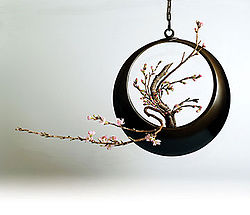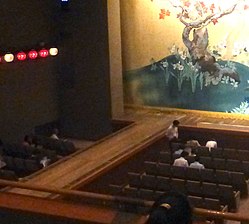花道
Hello, you have come here looking for the meaning of the word 花道. In DICTIOUS you will not only get to know all the dictionary meanings for the word 花道, but we will also tell you about its etymology, its characteristics and you will know how to say 花道 in singular and plural. Everything you need to know about the word 花道 you have here. The definition of the word 花道 will help you to be more precise and correct when speaking or writing your texts. Knowing the definition of花道, as well as those of other words, enriches your vocabulary and provides you with more and better linguistic resources.

花道 (kadō): a formal flower arrangement in the Enshū-ryū style of ikebana.

花道 (hanamichi): the hanamichi at the National Theatre of Japan, along the left side of the theater.
Chinese
flower; blossom; to spend flower; blossom; to spend; fancy pattern |
direction; way; method direction; way; method; road; path; principle; truth; reason; skill; Tao (of Taoism); a measure word; to say; to speak; to talk | ||
|---|---|---|---|
| trad. (花道) | 花 | 道 | |
| simp. #(花道) | 花 | 道 | |
Pronunciation
- Mandarin
- (Standard Chinese)+
- Hanyu Pinyin:
- Zhuyin: ㄏㄨㄚ ㄉㄠˋ
- Tongyong Pinyin: huadào
- Wade–Giles: hua1-tao4
- Yale: hwā-dàu
- Gwoyeu Romatzyh: huadaw
- Palladius: хуадао (xuadao)
- Sinological IPA (key): /xu̯ä⁵⁵ tɑʊ̯⁵¹/
- (Standard Chinese)+
- Cantonese
- (Standard Cantonese, Guangzhou–Hong Kong)+
- Jyutping: faa1 dou6
- Yale: fā douh
- Cantonese Pinyin: faa1 dou6
- Guangdong Romanization: fa1 dou6
- Sinological IPA (key): /faː⁵⁵ tou̯²²/
- (Standard Cantonese, Guangzhou–Hong Kong)+
Noun
花道
Synonyms
- 插花 (chāhuā)
Japanese
Etymology 1

| Kanji in this term | |
|---|---|
| 花 | 道 |
| か Grade: 1 |
どう Grade: 2 |
| kan'on | goon |
/kwadau/ → /kwadɔː/ → /kwadoː/ → /kadoː/
From Middle Chinese 花道 (MC xwae dawX).
Alternative forms
- 華道 (kadō)
Pronunciation
Noun
Usage notes
This term became more common during the Edo period as a synonym for ikebana, but with an emphasis on the elements of mental discipline.[1][2][3]
The 華道 spelling may be more common for the kadō reading, to more clearly distinguish from the hanamichi reading below.
Etymology 2

| Kanji in this term | |
|---|---|
| 花 | 道 |
| はな Grade: 1 |
みち Grade: 2 |
| kun'yomi | |
Compound of 花 (hana, “flower”) + 道 (michi, “road, way”).[1][2][4]
Likely derives from the early use of a hanamichi as a kind of walkway from the stage down into the audience, giving performers access to the audience in order to receive flowers.[1][2]
Pronunciation
Noun
- (theater) an extension of a stage that stretches into the audience, usually only in kabuki and most often along the left side of the theater, used mainly to enter and exit the stage
References
- ↑ 1.0 1.1 1.2 1.3 1.4 Matsumura, Akira, editor (2006), 大辞林 [Daijirin] (in Japanese), Third edition, Tokyo: Sanseidō, →ISBN
- ↑ 2.0 2.1 2.2 Shōgaku Tosho (1988) 国語大辞典(新装版) [Unabridged Dictionary of Japanese (Revised Edition)] (in Japanese), Tōkyō: Shogakukan, →ISBN
- ^ “花道”, in 世界大百科事典 第2版 (Sekai Dai-hyakka Jiten Dainihan, “Heibonsha World Encyclopedia Second Edition”) (in Japanese), Tōkyō: Heibonsha, 1998
- ^ Matsumura, Akira (1995) 大辞泉 [Daijisen] (in Japanese), First edition, Tokyo: Shogakukan, →ISBN
